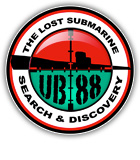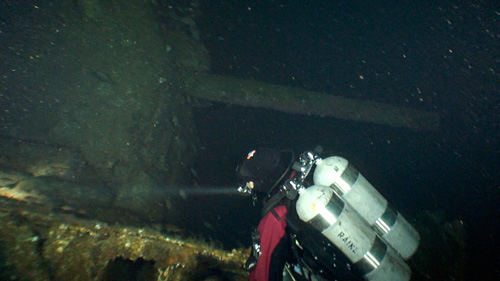
Kendall Raine inspects one of the 5-inch deck guns of a newly discovered Fletcher Class Destroyer off the coast of San Clemente Island, California. The unidentified ship was likely sunk as a target off the Navy-owned island during a live fire exercise. Photo by John Walker.
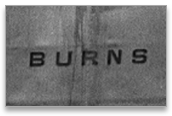
|
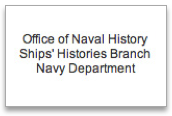
|
World War II Era Destroyer
Found Off San Clemente Island
The UB88 Team has located and dived what is believed
to be an intact Fletcher Class Destroyer in deep water
off the coast of San Clemente Island.
Dive Report
by Kendall Raine
On
Saturday, December 12, 2009 Captain Ray Arntz, Captain
Kyaa Heller, John Walker and I traveled to San Clemente
Island aboard Sundiver II to dive a large unknown target.
We knew about the existence of the object from the
efforts of Dean Morrow who has corresponded with Gary
Fabian over the years about various bathymetric matters.
Our own bathymetric analysis suggested it was a vessel
over 350 feet in length with over 30 feet of relief. In
other words, a warship on its side. We also knew the Navy
was fond of using old warships for target practice and
research indicated at least several Destroyers (DD) and
Destroyer Escorts (DE) sunk in the ‘60’s and
'70's off San Clemente.
Weather conditions were snotty as we left Peter's Landing
at 5:00 am. A 5 foot west swell with 3 feet of wind wave
out of the south and 15-20 kt winds and rain guaranteed
an interesting trip. At least we’d probably have
the island to ourselves.
When we reached Clemente, we ran into a small cove
protected from the west swell in order to finish gearing
up and rigging the boat before poking out into the full
force of wind and swell. Our plan was to live boat and
recover the heavy gear using a winch and A frame of John
and Ray's design. This would spare us the excitement of
trying to reboard with heavy gear in a heavy sea.
Conditions in the protected cove told us the sea state on
site would be pretty wild. We then headed directly into
the west swell and things got a little sporty.
Despite the lumpy sea Ray located the wreck immediately
and we wasted no time gearing up and getting into the
water. We did our checks at a more sedate 20 feet and
headed down the line. Viz improved during the descent.
Visibility improved as we descended through 200 feet.
Around 50 feet above the wreck I could make out a very
large but indistinct shape below. 20 feet above the port
side appeared as a featureless mass. The hull looked
massive and reminded me of descending onto the hull of
the Andrea Doria. It took a minute to make out the bottom
from the top of the hull. Current was blowing about half
a knot from stern to bow. We turned up current and
started kicking up to the main deck. As we dropped over
into the superstructure the current eased a bit and we
were able to relax and take in the sheer size of the
wreck. As planned, Ray’s spot put us amidships and
the first object I identified was a life boat davit
extending from the port side. Next, twin stacks came into
view, collapsed in the sand below us. Heading aft, I came
upon a rack of five torpedo tubes. The rack of five
suggested we were on a DD and not a DE. I signaled John
to film the tubes and headed aft. John's video lights
cast a huge white glow over the scene. The tubes exploded
in various shades of pink and green from the soft corals
growing on them. Numerous hatch openings in the deck
allowed me to peer below. Our mission today was external
survey, but staying outside was hard to do when looking
at the wonders inside.

A single smoke stack laying in the sand.
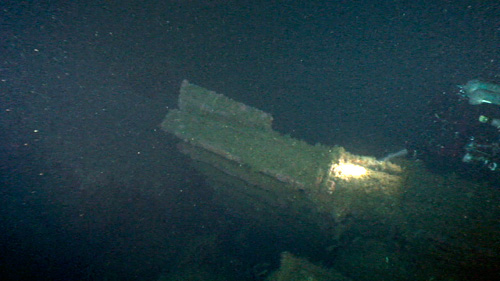
A quintuple set of torpedo tubes.
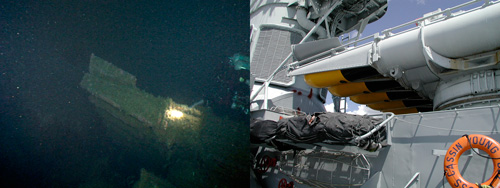
A side by side comparison with the torpedo tubes of USS
CASSIN YOUNG (DD-793).
I
came across a 5 inch gun and turret further aft. This was
facing towards the bow with the barrel ablaze with
vibrant pink Corynactis. I rolled under the turret and
swam up into an open hatch enough to examine the weapon
inside. As I descended again John had leapfrogged me and
his lights illuminated another turret facing aft.
Back to back 5 inch guns pretty well eliminated the ship
as a DE. It’s ironic the most colorful features of
the whole wreck were the destructive ones-main armament
and the torpedo tubes-almost something out of the movie
Yellow Submarine.
We swam past the aft gun and saw a large circular steel
patch on the deck. This looked like a patch over the
third main aft armament (Turret 55) barbette. I looked up
and saw John 20 feet ahead of me shooting a large
propeller. The props were covered with large brown basket
sponges which tend to live on deeper wrecks. These
sponges increased in size and number heading aft, which
suggested their preference for unobstructed access to
current.

One of the destroyer's large
propellers.
At 15
minutes we turned and rode the current forward. I used
the time to pause and examine various open hatches.
Destroyers aren't known for crew comfort and the tight
confines of the ship were obvious from peering into these
hatches. Penetration would be tricky given the tight
quarters and the fact the wreck was on its
side.
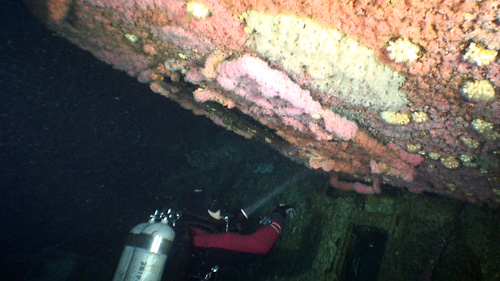
Kendall peers inside a 5-inch gun turret.
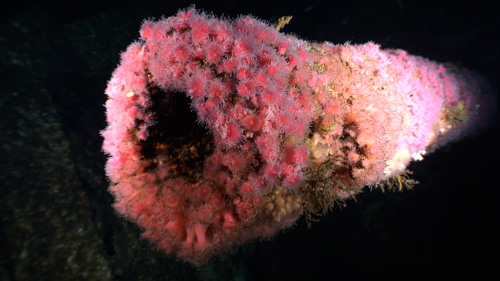
The business end of one of the destroyer's 5-inch guns.
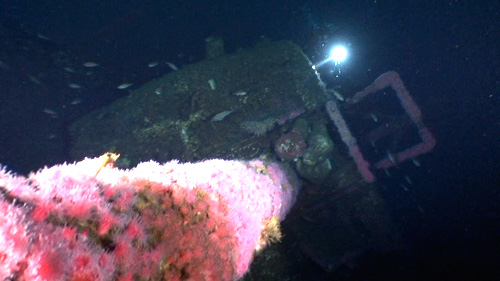
Another view of a 5-inch gun barrel and turret. Kendall
Raine is in background.
At
20 minutes we called it a day and started the long deco.
I wondered what surface conditions would be like after
our two hour dive. Sea conditions were marginal when we
jumped in. If things had gone to hell in the meantime it
would take all Ray's skill plus a little luck to get us
back on board.
As often happens on deco hangs I had time to think about
the beauty of the wreck and what a vibrant eco system it
has become. This wreck is untouched and covered with fish
including large ling cod and wolf eels, basket sponges,
tunicates in purple and orange. It struck me how pretty
this wreck was compared with the USS Wilkes Barre off Key
West, which now bears the refuse and damage of almost 40
years of fishing and hammer wielding wreck divers. I
thought about what a great example this would be for
California Ships to Reefs. If we’re right about the
ship’s identity, it’s only been down a few
decades and yet has become a home to thousands of fish
and other marine life. What if California could get out
of its own way and do this with the rotting mothball
fleet in Suisun Bay?
As we did our gas switches at 70 feet a sea lion
performed Split S's and Cuban Eights for our amusement.
Settling into the 20 foot stop, I looked up as a Pacific
dolphin circled us 10 feet away before heading up for
air. I hadn’t seen a dolphin underwater since Cocos
Island in 1993. I took this as a good omen for the last
phase of the dive-getting aboard Sundiver II without
scratch and dent. There was almost no swell effect at 20
ft so I was hopeful things had held up topside.
Finally at the surface, John and I were relieved to find
no change in sea state. Ray and Kyaa deftly maneuvered
alongside and we passed up deco bottles and video. We
then wriggled out of our harnesses and they were winched
aboard. This allowed us to time the swell and body surf
through the transom door of Sundiver II.
Despite running downhill at a crisp 23 kts back to
Peter’s, we had to wait until we were tied up
before we could really appreciate the high quality of
John’s video. We felt very privileged to dive this
pristine warship in its untouched state. It is the
largest intact warship in California in diveable depths
of which we’re aware and a true E ticket ride.
Future dives will be directed at filming the forward
section of the wreck and on confirming identification.
Video
by John Walker
